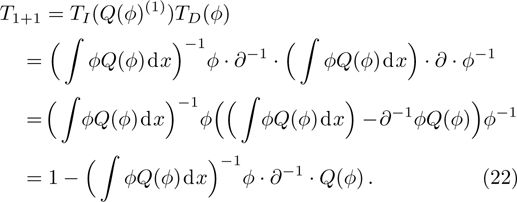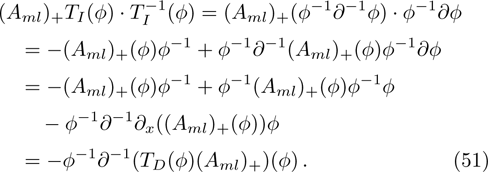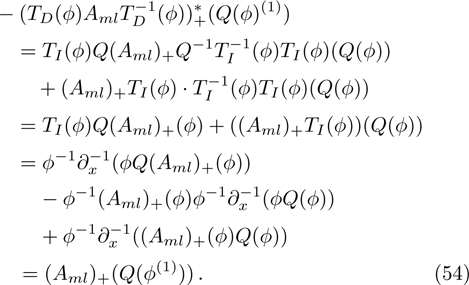1. IntroductionThe Kadomtsev-Petviashvili (KP in short) hierarchy[1–2] is an important research area in the integrable systems. There is a kind of sub-hierarchy of the KP hierarchy studied by Date et al. in Ref. [3], which can be viewed as the generalization of the BKP and CKP hierarchies.[1,3–5] In Ref. [4], Zuo et al. made a slight modification for the sub-KP hierarchy of Ref. [3], and called it the BCr-KP hierarchy, to ensure its consistence with the CKP and BKP hierarchy in the case of r = 0 and r = 1 respectively. In Ref. [4], Zuo et al. not only constructed the additional symmetries of the BCr-KP hierarchy and its constrained case, but also showed that the corresponding additional symmetries form a
 -algebra and a Witt algebra respectively. In this paper, we will consider the gauge transformations and its relation with the additional symmetry of the BCr-KP hierarchy.
-algebra and a Witt algebra respectively. In this paper, we will consider the gauge transformations and its relation with the additional symmetry of the BCr-KP hierarchy.
The gauge transformation[6–8] is an efficient way to construct solutions for integrable hierarchies. Its initial ideal dates back to the gauge equivalence with the different integrable models. The gauge transformation operators of the KP hierarchy[6–7] mainly included the differential type TD and the integral type TI. Now, the gauge transformations of many important integrable hierarchies have been constructed. For instance, the KP and modified KP hierarchies,[6–11] the BKP and CKP hierarchies,[12–14] the q-KP and modified q-KP hierarchies,[15–18] the discrete KP and modified discrete KP hierarchies.[19–21] In this paper, we focus on the gauge transformation operators of the BCr-KP hierarchy and its constrained case. Different from the KP hierarchy, the gauge transformations of the BCr-KP hierarchy must keep the
 -constraint invariant, besides keeping the Lax equation. It is found in this paper that the combination of TD and TI is the suitable choice of the gauge transformation for the BCr-KP hierarchy. As for the constrained case, the corresponding gauge transformations have to ensure the constrained form of the Lax operator unchanged, besides the two conditions in unconstrained case. In fact, this can be done, by choosing the eigenfunction in the negative part of the Lax operator as the generating function in the gauge transformation operators. What is more, the successive applications of the corresponding gauge transformation operators are considered in this paper.
-constraint invariant, besides keeping the Lax equation. It is found in this paper that the combination of TD and TI is the suitable choice of the gauge transformation for the BCr-KP hierarchy. As for the constrained case, the corresponding gauge transformations have to ensure the constrained form of the Lax operator unchanged, besides the two conditions in unconstrained case. In fact, this can be done, by choosing the eigenfunction in the negative part of the Lax operator as the generating function in the gauge transformation operators. What is more, the successive applications of the corresponding gauge transformation operators are considered in this paper.
Another topic in this paper is the additional symmetry.[1–2,22–24] The additional symmetries are from the
 algebra[24] or the so-called centerless
algebra[24] or the so-called centerless
 -algebra, which are an exceptional kind of symmetries relying explicitly on the space and time variables.[25–28] Nowdays, there are many important results on the additional symmetries.[4,29–35] In this paper, we will study the compatibility of the additional symmetries and the gauge transformation for the BCr-KP hierarchy. It is an interesting question to discuss the changes of the additional symmetries under the gauge transformations. For the BCr-KP hierarchy after the gauge transformation, we find that the additional symmetries remain the ones, which shows some compatibilities of the additional symmetry and the gauge transformation.
-algebra, which are an exceptional kind of symmetries relying explicitly on the space and time variables.[25–28] Nowdays, there are many important results on the additional symmetries.[4,29–35] In this paper, we will study the compatibility of the additional symmetries and the gauge transformation for the BCr-KP hierarchy. It is an interesting question to discuss the changes of the additional symmetries under the gauge transformations. For the BCr-KP hierarchy after the gauge transformation, we find that the additional symmetries remain the ones, which shows some compatibilities of the additional symmetry and the gauge transformation.
The organization of this paper is as follows. In Sec. 2, some backgrounds of the BCr-KP hierarchy are introduced. In Sec. 3, the gauge transformations for the BCr-KP hierarchy are given to keep the
 -constraint. In Sec. 4, the gauge transformation for the constrained BCr-KP hierarchy on the Lax operator are investigated. In Sec. 5, we focus on the compatibility of the gauge transformations and the additional symmetries.
-constraint. In Sec. 4, the gauge transformation for the constrained BCr-KP hierarchy on the Lax operator are investigated. In Sec. 5, we focus on the compatibility of the gauge transformations and the additional symmetries.
2. Background on the BCr-KP HierarchyIn this section, we will review the backgrounds on the BCr-KP hierarchy,[4] based upon the pseudo-differental operators. The multiplication of
 with the f obeys the Leibnitz rule[2]
with the f obeys the Leibnitz rule[2]

For
 , we denote
, we denote
 and
and
 . What is more, Af or
. What is more, Af or
 means that the multiplication of A and f, while
means that the multiplication of A and f, while
 denotes the action of A on f. The conjugate operation * obeys the following rules:
denotes the action of A on f. The conjugate operation * obeys the following rules:
 ,
,
 ,
,
 , for any pseudo-differential operators A and B and any function f.
, for any pseudo-differential operators A and B and any function f.
Let us introduce the KP hierarchy[1–2] firstly, since BC
r-KP hierarchy is a kind of sub-hierarchy of the KP hierarchy. The Lax equation of the KP hierarchy is defined by

Here the Lax operator is given by

and
 is called the dressing operator. And the coefficients
is called the dressing operator. And the coefficients
 are the functions of infinitely many variables
are the functions of infinitely many variables
 . The Lax equation (2) is equivalent to the Satoʼs equation:
. The Lax equation (2) is equivalent to the Satoʼs equation:

The eigenfunction ϕ and the adjoint eigenfunction ψ of the KP hierarchy are defined by

respectively.
Next introduce

where S is the dressing operator of the KP hierarchy. Generally, the BCr-KP hierarchy[3–4] can be defined by imposing the condition below on the dressing operator S,

which means that Q is an r-order differential operator satisfying
 . Further according to Eqs. (3) and (4), one can find
. Further according to Eqs. (3) and (4), one can find


and by talking the negative part and using Q=Q
+, one gets
 . Therefore, the BCr-KP hierarchy only has odd flows.
. Therefore, the BCr-KP hierarchy only has odd flows.
By summarizing the results above, the BCr-KP hierarchy is defined by

and the Lax operator L in Eq. (3) has the reduction condition (7) or (8). Notice that
(i)
 -KP is the CKP hierarchy. When r = 0, one can find Q = 1 and
-KP is the CKP hierarchy. When r = 0, one can find Q = 1 and
 .
.
(ii)
 -KP is the BKP hierarchy. When r = 1, one can find
-KP is the BKP hierarchy. When r = 1, one can find
 and
and
 .
.
According to Eqs. (5) and (8), it can be found that the adjoint eigenfunction of the BCr-KP hierarchy can be expressed by
 , where ϕ is an eigenfunction. The constrained BCr-KP hierarchy[4] is defined by imposing the below constraints on the Lax operator of BCr-KP hierarchy
, where ϕ is an eigenfunction. The constrained BCr-KP hierarchy[4] is defined by imposing the below constraints on the Lax operator of BCr-KP hierarchy

where
 and
and
 are two eigenfunctions of the BCr-KP hierarchy.
are two eigenfunctions of the BCr-KP hierarchy.
3. The Gauge Transformation for the BCr-KP HierarchyIn this section, we will consider the gauge transformation of the BCr-KP hierarchy.
Firstly, let us review the gauge transformation of the KP hierarchy.[6–7] Assume that T is a pseudo-differential operator and L is the Lax operator of the KP hierarchy. Denote
 and
and
 . If
. If
 still holds, then T is called the gauge transformation operator for the KP hierarchy. There are two elementary types of the gauge transformation operator in the KP case.
still holds, then T is called the gauge transformation operator for the KP hierarchy. There are two elementary types of the gauge transformation operator in the KP case.

where ϕ and ψ are the eigenfunction and adjoint eigenfunction respectively.
Given eigenfunction
 and adjoint eigenfunction
and adjoint eigenfunction
 for
for
 , consider the following chain of the gauge transformation operators
, consider the following chain of the gauge transformation operators
 and
and
 .
.

Denote

The next proposition will give the explicit form of
 . For this, the generalized Wronskian determinant[9] will be needed, which is defined by
. For this, the generalized Wronskian determinant[9] will be needed, which is defined by

 [9]
[9]
 and
and
 have the following forms
have the following forms


Before further discussing, the next lemma will be needed.
 [7,11] For any functions f and any pseudo differential operator
[7,11] For any functions f and any pseudo differential operator
 ,
,



where
 .
.
After the above preparation, we begin to consider the gauge transformations of the BCr-KP hierarchy. The gauge transformation operator T of the BCr-KP hierarchy must satisfy the following two conditions, which are different from the KP hierarchy, that is
(i) Keeping the Lax equation:
 , where
, where
 and
and
 .
.
(ii) Keeping the
 -constraint:
-constraint:
 , where
, where
 .
.
However in the BCr-KP hierarchy, single TD or TI can not ensure the
 -constraint invariant. Fortunately, it is found that the combination of TD and TI, i.e.,
-constraint invariant. Fortunately, it is found that the combination of TD and TI, i.e.,
 , can satisfy the two conditions above. We will show this fact below.
, can satisfy the two conditions above. We will show this fact below.

with
 .
.
 Firstly by using
Firstly by using
 ,
,

Similarly

therefore

Then according to Eqs. (22), (24) and Lemma 1,

Further according to Lemma 1

By subsituting Eq. (26) into Eq. (25) and using the relation
 , one can at last obtain Eq. (21).
, one can at last obtain Eq. (21).

 The results in Proposition 3 contain the gauge transformation operators of the CKP and BKP hierarchies:[12–14]
The results in Proposition 3 contain the gauge transformation operators of the CKP and BKP hierarchies:[12–14]
(i) The CKP hierarchy:
 .
.
(ii) The BKP hierarchy:
 .
.
 In general
In general
 , though
, though
 , when r = 0 or r = 1.
, when r = 0 or r = 1.
4. The Gauge Transformation for the Constrained BCr-KP HierarchyIn this section, we will consider the gauge tranformation of the constrained BC
r-KP hierarchy. Before doing this, let us review some results on the gauge transformations of the constrained KP hierarchy first.
 [10,13] For the constrained KP hierarchy
[10,13] For the constrained KP hierarchy

under the gauge transformation
 , we have
, we have

where







Here
 ,
,
 ,
,
 ,
,
 .
.
As for the case of the BCr-KP hierarchy
 , the corresponding gauge transformation operator T has to satisfy the following conditions:
, the corresponding gauge transformation operator T has to satisfy the following conditions:
(i) Keeping the Lax equation:
 , where
, where
 and
and
 .
.
(ii) Keeping the BCr-KP constraint:
 , where
, where
 .
.
(iii) Keeping the form of Lax operator:
 .
.
The required gauge tranformation operator T is given in the next proposition.
 For the constrained BCr-KP hierarchy
For the constrained BCr-KP hierarchy

the gauge transformation operator is given by
 . Under the gauge transformation
. Under the gauge transformation
 , the Lax operator L will become into
, the Lax operator L will become into

where



 In order to prove
In order to prove
 is the gauge transformation of the constrained BCr-KP hierarchy, we only need to show
is the gauge transformation of the constrained BCr-KP hierarchy, we only need to show


where
 .
.
When i = 1, according to Proposition 3,


where we have used
 , the BCr-KP constraint (8) and
, the BCr-KP constraint (8) and
 .
.
For
 and j=1,2,
and j=1,2,


According to Proposition 1 and 4, we can know that
 For the constrained BCr-KP hierarchy
For the constrained BCr-KP hierarchy
 , under n-step gauge transformations
, under n-step gauge transformations
 , we have
, we have

where




where
 , j=1,2,
, j=1,2,
 .
.
 When r = 0 and r = 1, the corresponding results in Proposition 5 are consistent with the cases in Ref. [13].
When r = 0 and r = 1, the corresponding results in Proposition 5 are consistent with the cases in Ref. [13].
5. The Additional Symmetry and the Gauge Transformation for the BCr-KP HierarchyIn this section, we will discuss the compatibility of the additional symmetry and the gauge transformation operators for the BCr-KP hierarchy.
At first, additional symmetries for the BCr-KP hierarchy[4] will be introduced. Denote

which satisfies
 and
and
 . And let
. And let

satisfying

Assume that
 are additional independent variable, where
are additional independent variable, where
 and
and
 . Additional symmetries for the BCr-KP hierarchy are defined by the additional symmetries flows
. Additional symmetries for the BCr-KP hierarchy are defined by the additional symmetries flows
 , whose actions on the Lax operator and the dressing operator are defined by
, whose actions on the Lax operator and the dressing operator are defined by

Some lemmas will be needed when we consider the additional symmetries under the gauge transformations for the BCr-KP hierarchy.
 For the eigenfunction ϕ of the BCr-KP hierarchy
For the eigenfunction ϕ of the BCr-KP hierarchy

 By the following direct computations
By the following direct computations

 For the eigenfunction ϕ of the BCr-KP hierarchy
For the eigenfunction ϕ of the BCr-KP hierarchy

where
 .
.
 According to Eqs. (18), (48), and (50)
According to Eqs. (18), (48), and (50)

Therefore


With these preparations, we can get the following results.
 For the BCr-KP hierarchy, the additional symmetry flows can commute with the gauge transformations
For the BCr-KP hierarchy, the additional symmetry flows can commute with the gauge transformations
 , that is
, that is


if and only if the eigenfunction ϕ transforms under the additional symmetries in the following way

 Firstly, according to Eq. (49)
Firstly, according to Eq. (49)

On the other hand

thus Eq. (55) holds, which means

By Eqs. (18), (19), and (52)


According to Eqs. (61), (62), Eq. (60) is true if and only if















































































































































































